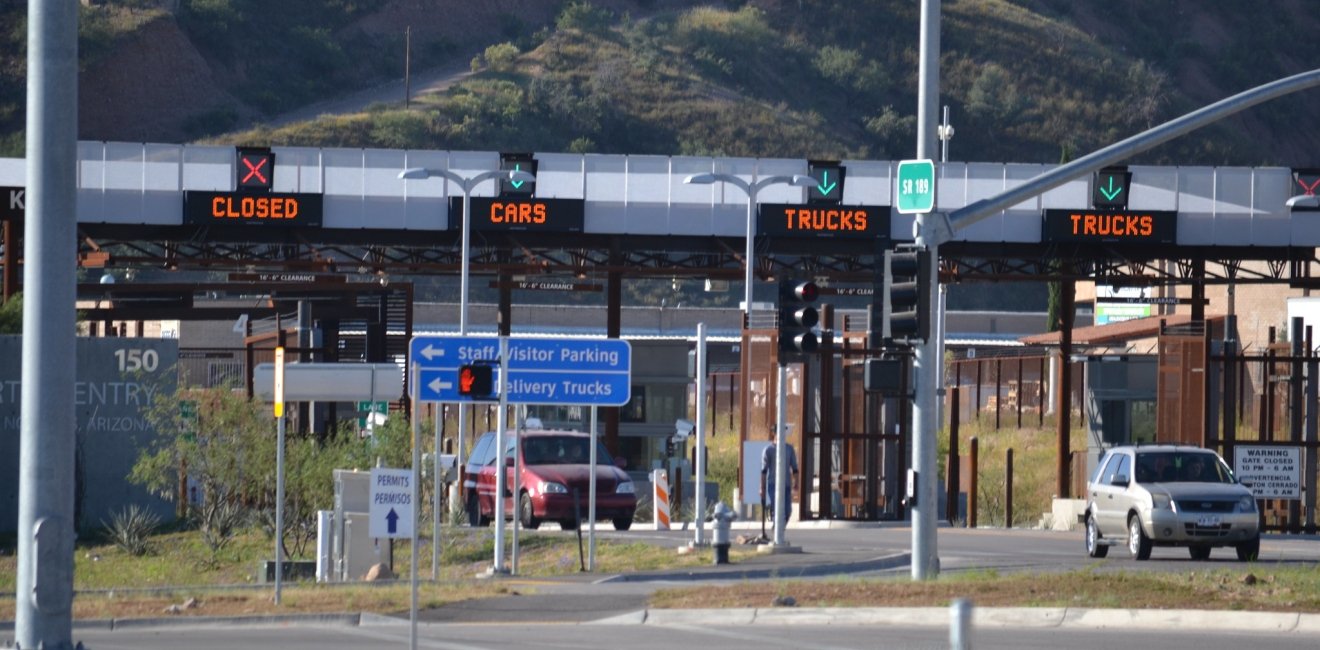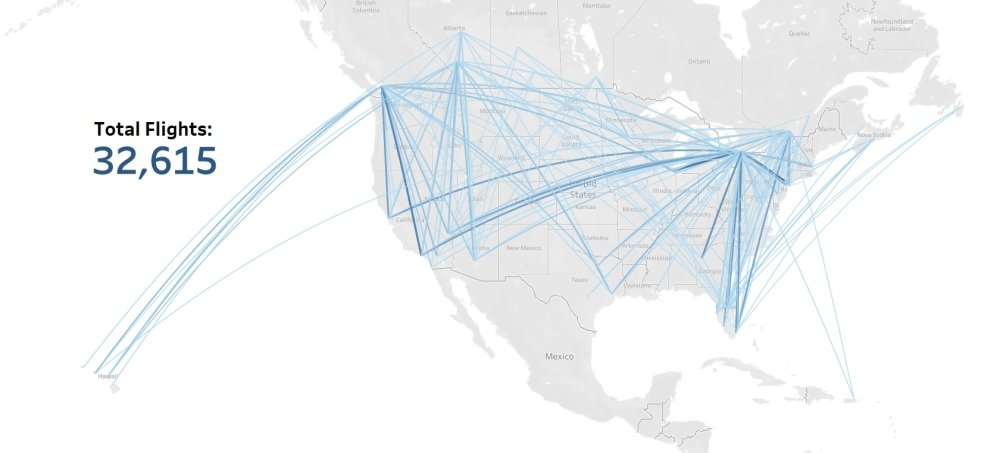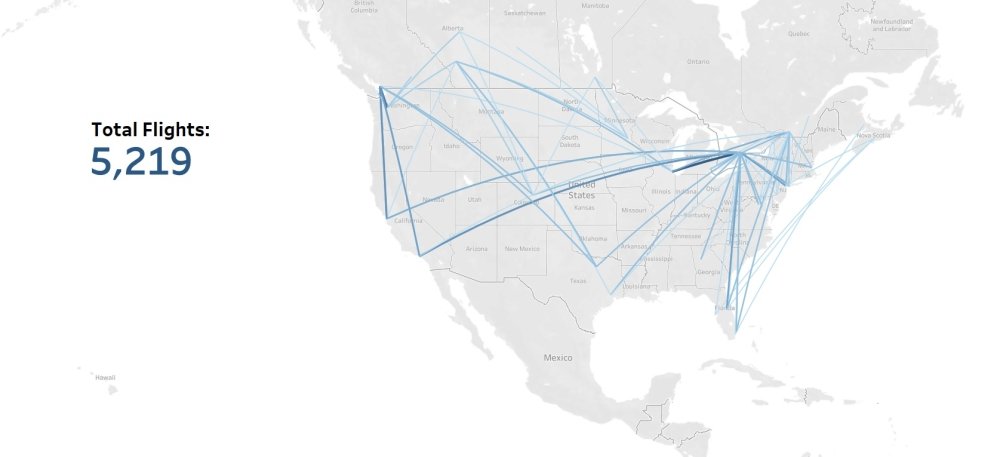Reports from North America’s Borders: Experts React to New COVID-19 Travel Restrictions
Experts across the continent react to the travel restrictions put in place at the U.S.-Canada and U.S.-Mexico borders to slow the spread of COVID-19.
Experts across the continent react to the travel restrictions put in place at the U.S.-Canada and U.S.-Mexico borders to slow the spread of COVID-19.

What impact is COVID-19 having on the U.S. - Mexico border? Like the rest of the world, we are coming to grips with rapid changes in our lifestyle and what that means for our families, friends, businesses, and binational way of life. I'm certain that trade and positive relations with Mexico have never been more critical.
Today, non-business and non-essential travel over land ports of entry is restricted. However, the border is not closed, and trade with Mexico will continue. While not ideal, these restrictions aim to slow the COVID-19 spread, without shutting down supply chains. Halting cross-border life is painful. The alternative is worse. Saving lives requires isolation and, thus, reduced travel. The sooner citizens on both sides of the border comply, the sooner we can return to our normal lifestyle. It is imperative that Mexico coordinates with U.S. health officials in adopting plans, including stay at home orders, to combat COVID-19.
From my office, I can see one of the busiest international crossings in the world. It's a daily reminder of the interdependence between our nations and critical supply chains that allow for jobs, hope, and opportunity on both sides of the border. Working cooperatively with Mexico, we will defeat this virus, save lives, and identify new opportunities for economic growth. As the fourth largest manufacturing hub in North America, I firmly believe that once this virus is defeated, the Borderplex region will play a vital role in reigniting the global economy.
Already, we are receiving keen interest from logistics and other companies along the supply chain looking to move or expand to our region to accommodate business growth when the COVID-19 crisis is over. Our region will be viewed as a model for international cooperation, economic development, and calm leadership during times of crisis. The U.S.-Mexico border is resilient, and we will emerge from this crisis stronger than ever.
We do not have a binational policy to manage a crisis of this magnitude. This should become a priority for a resilient region such as this one. With 300,000 daily crossings happening right before March 21, it is almost surreal to see that we had a local and national emergency on the U.S. side of the San Ysidro Port of Entry and an entirely insufficient government-declared Phase One 200 yards south in Tijuana. We are realizing that our binational collaboration efforts on health and security require a much higher level of strategy and decisive action.
We are still some time away from understanding all the implications that border restrictions are having, but there are several visible threads. Clearly, crossings at our ports are dramatically down from “normal levels” of two weeks ago. We have had 70-85% reductions, depending on the time of day and day of the week. Tourism, hospitality and restaurant industries in our region have borne the brunt of the impact. Hotel occupancy is below 20%, and most restaurants have closed and are attempting pick-up services. Manufacturing in Tijuana is starting to feel the pinch. Capacity in the medical and electronics industries is at 75%; the automotive and aerospace sectors are at 50% levels or lower.
There has been a great deal of misinformation and fake news about Custom and Border Protection’s (CBP) screening activities, with unfortunate false claims that Mexican nationals crossing for non-essential purposes are being stripped of their travel documents. We believe CBP must reach out as frequently as possible to contacts in the business and non-profit environments to convey clarifying information. For its part, Tijuana has yet to establish health screening teams for southbound pedestrians at either the San Ysidro or Otay Mesa Ports of Entry. Tecate, in eastern San Diego County, had its screening in place as of the beginning of this week. Cargo is still moving smoothly, though with slight reductions. A number of issues are being discussed, from duty payment postponement to U.S. warehouses filling up with merchandise or perishables, to worries that factories and/or borders will close if there is a spike in infections in Tijuana.
As I write these lines, Mexico is now in Phase Two of COVID-19. Tijuana’s mayor has declared a state of “health risk” emergency. Hugo López-Gatell, Mexico’s Director for Health Prevention and Promotion, has just stated that “this is the moment” for people to stay home to flatten the curve of the epidemic and avoid what happened in Italy. There are 297 COVID-19 cases in San Diego, a third person has died, the Theodore Roosevelt carrier has been sidelined due to three novel coronavirus cases, and a former candidate for California governor has tested positive. The news firehose will not let up.
Ironically, as we all stay home, we have witnessed and been part of an explosion of conversations, whether through texting, WhatsApp groups, webinars, or phone calls. We are communicating more than ever with our colleagues and the community, but we are not yet at the point of concerted action for the border. Our dialogue still has a high level of dissonance.
The CaliBaja region has answered the call to action – the action of staying at home. Even before travel restrictions were put in place at the border, the cross-border community had largely scaled back its activity. Those who can work remotely, are doing so. Many who have family across the border are no longer crossing to visit each other. One day before the Mexican and U.S. governments announced that non-essential travel across the border would be restricted, California Governor Gavin Newsom issued a stay at home order. Essential operations and their workforce as defined by the state order, largely matched the description of essential travel that would be permitted across the border. What is not deemed essential is tourism and recreation. With bars, amusement parks, sporting and cultural events halted, it is retail and restaurants – those still open – that are adversely impacted by the border restrictions. Tourism is San Diego’s second most significant economic driver, with military and defense as number one. For Baja, tourism is also critical and has also mostly halted. While the reduction in cross-border activity is a painful and a tremendous hit to our economies, we know it is necessary in order to combat the spread of the virus. The sooner we take action, the sooner we can overcome this adversity and restart our economies.
Meanwhile, nearly all our local manufacturing plants continue to operate, and our supply chains remain without disruption. This is important not only for our economy, but as a critical part of the fight against the COVID-19 disease. The CaliBaja region is home to the largest medical device manufacturing cluster in the world where we produce personal protective equipment (PPEs) and components for ventilators among other lifesaving products. Facilitating the movement of these goods across the border as well as the workforce that supports these supply chains is of utmost importance.
While local, state, and federal government orders on the northern side of the border took effect, it was largely the private sector in Baja which led efforts to impose social distancing measures and shift labor to remote operations where possible. The cross-border community, having extensive experience working together and having fostered deep lines of communication, has been sharing information, concerns, ideas, and inspiration. Ours is a border region with strong binational ties and coordination that is mirrored across sectors. We understand the importance of working together to address our greatest challenges because our success and future is dependent on each other. Neither side of the border can succeed if one fails. We support each other and most importantly, we know each other. Our past adversity has prepared us for this moment.
A Positive Example Set at North American Borders
As COVID-19 spreads through the world — as nothing we've seen since the Spanish Flu a century ago — the borderless and technologically accelerated dimensions of globalization are on vivid display. Reciprocally, the virus has intensified the negative, populist political reaction to globalism already evident before the pandemic. The European Union has sealed its external boundaries, and its members have introduced stringent land border checks, and some complete shutdowns, within the Schengen Zone itself. Globally, international travel zones, by air and sea, are well on their way to shutting down for most ordinary intents and purposes.
All pretty dismal, which is why it is so extraordinary — and a powerful exemplar — that a silver lining can be found in the pragmatic, sensible way the Governments of Canada, Mexico and the United States have reacted thus far to the crisis. The uncertainty and fear gripping the world has placed previously unthinkable notions — such as a border lockdown — on the table for reconsideration along with virtually all else in everyday life. For the first time, the security problem on U.S. borders both with Canada and Mexico, is not "finding a (high risk) needle in the haystack" of massive lawful trade and travel. Instead, the threat of contagion from COVID-19 has made the entire haystack of cross-border movement itself a risk. The logic of "social distancing and remain in place" could clearly have counseled complete and extended border closure from the outset; and it would not have been surprising were such a sweeping security measure imposed unilaterally by the United States as so many have been in the wake of 9/11.
But that is not the way it has unfolded. Instead the North American response emerged following close and coordinated consultation. Although conducted in “parallel bilateral fashion” (between the U.S. and each of its neighbors), a trilateral result was reached among the three governments: to limit spread of the coronavirus, non-essential travel was curtailed while cross-border trade ($3.4 billion daily) remained unconstrained. This policy consensus represented an obvious compromise — in the border context — between the epidemiological dictates of public health and the supply chain requirements of an integrated continental production platform. It may be that events render this border balance of interest unsustainable (rather than a model for domestic application generally). As with so much else in the current situation, only time will tell. Nonetheless, the border management decisions taken this week in the crucible of crisis, embody the clearest demonstration to date of how deeply interconnected, economically and socially, North America has become and will remain in the future.
That these actions were taken by leaders in the three countries who do not really trust one another — in an era of counter-globalization to which two of them subscribe — leaves the lesson even more undeniable and compelling.
On March 21st, the Department of Homeland Security began restricting non-essential travel at North America’s two internal land borders. Importantly, these measures were not imposed unilaterally by the United States. Instead, they were negotiated, announced, and implemented in partnership with Canada and Mexico. The restrictions, not coincidentally but rather because they were created with the support and collaboration of our neighbors, were designed to maximize health benefits while ensuring the continued functioning of vital cross-border supply lines, which bring food and medical supplies to our communities. Collaboration and coordination are hard in the best of times. To maintain such an approach during a time of international crisis is a huge achievement. It reflects the years of effort, institution building, and trust that has been developed over the past two decades. The COVID-19 crisis is the moment the authorities in charge of border management for the three governments of North America have been preparing for since 9/11.
In the wake of the September 2001 attacks, the United States ordered the full inspection of every vehicle and person seeking to cross the U.S.-Mexico and U.S.-Canada borders. This slowed border crossings to a trickle, which in turn created a pile-up of traffic so large that people began to abandon their vehicles. In effect, the border was shutdown. The United States made and implemented the decision unilaterally. The move was understandable given the moment of crisis and uncertainty around the possibility of continued attacks, but it created massive disruption for manufacturers and farmers experiencing supply chain disruption as well as people living and working in border regions that had come to depend on an efficient border as a part of their day-to-day lives.
For Canada and Mexico, 9/11 was a wake-up call. Canada, which sends 76 percent of its exports to the United States, led the way in working with the United States to improve border security and thereby prevent the need for any future border closure. The United States and Canada signed the Smart Border Declaration in December 2001, implemented it over the following years, and deepened cooperation through the Beyond the Border action plan in 2011, which institutionalized the notions of co-management of the border and cooperation on perimeter security. It is worth noting that this time around the same pattern was followed, with Canada acting first to negotiate with the United States and then Mexico taking advantage of the precedent to achieve similar results.
Mexico, albeit starting from a place of less trust and cooperation, followed Canada’s lead and dramatically increased its cooperation with U.S. officials at the U.S.-Mexico border. The United States and Mexico signed their own Smart Border Agreement in 2002 and followed that up with a more ambitious declaration on 21st Century Border Management in 2010. Executive Steering Committees were created for both pairs of countries to jointly plan and coordinate border management tasks. Concerns about the spread of first H5N1 and then H1N1 during the 2000s caused pandemic response to be carefully integrated into the evolving border management protocols.
The bureaucratic mechanisms were multiple and at times complex, but the idea was simple: Mexico and Canada agreed to deep cooperation to secure the United States’ land borders in order to protect their access to the U.S. market and gain a seat at the table where key decisions regarding border management were made. By agreeing to co-manage its land borders with its neighbors, the United States gained valuable partners in its efforts to secure the homeland.
Since 9/11, the countries of North America have faced numerous challenges in terms of border management, but none have created a serious risk of a total shutdown of the national boundaries in the way that COVID-19 has. Though unprecedented, this is just the crisis that North America has been preparing for since 2001. The three countries trade more than a trillion dollars’ worth of goods each year, supporting some 12 million jobs and bringing essential foods, medicines, and medical devices to our communities. That interdependence may seem risky in a time of emergency, and indeed it would be if we could not count on our neighbors to help out in times of trouble. Thankfully, in the case of Canada and Mexico, when it comes to jointly implementing thoughtful measures to manage our borders in ways that safeguard our communities, it is quite clear that we can.
COVID-19 emerged as the most relevant health threat to humankind in our lifetime, and taking care of every person has become the top priority. In order to ensure that, a broad scope of priorities have also arisen as essential, trade and logistics being one of them.
As Mexican Customs Brokers, we are working in coordination with the Mexican Government and the trade community in order to assure Mexico's logistics capability, which is fundamental, especially for the North American region. Our focus is not only the correct and legal movement of goods, but also to be a facilitator of trade in times where priorities have changed.
Trade operations at the U.S. - Mexico border continue to be completely operative and will remain functioning, as well as all Mexican ports of entry, giving certainty to importers and exporters that Mexico is prepared to strengthen its efforts to overcome this crisis. It is our commitment to work with all the logistics players in order to guarantee the fulfillment of the rule of law and maintain trade flows as are needed.
Even though we are facing times of uncertainty, we recognize the Mexican Customs Authorities for their responsibility and correct vision of understanding that safe trade of goods among nations is essential to overcome this major humanitarian, social, and economic crisis.
In order to make this possible, we are enforcing very strict safety protocols in every brokerage facility and in coordination with the authorities, following specific guidelines and measures in every port of entry.
Mexican Customs Brokers will always maintain our commitment to ensure all health and sanitarian regulations are fulfilled in every trade operation between Mexico and our trade partners around the world.
Companies supplying fresh fruits and vegetables feel the full weight and responsibility of being a critical part of the U.S. national infrastructure. With much of the country in a “stay safe” mode, food companies have the challenge of keeping their doors open, while keeping their eyes and ears open for activities that might compromise ongoing efforts to combat COVID-19.
As labor and logistics businesses at the border, we work with State and Federal authorities to make sure companies abide by current CDC and WHO guidance on how to continue operations while keeping their people, their partners, and their products safe.
Although our industry is critical infrastructure, sometimes people in our industry, including agriculture inspectors and truck drivers, get delayed at the border. They have to prove they are crossing to work in this critical infrastructure. But we are not discouraged, for this is evidence that the system is working, that the authorities are doing their due diligence.
Now more than ever, we have to rely on a sense of partnership with regulators at the border, including Customs and Border Protection, the Food and Drug Administration, and the U.S. Department of Agriculture. They are adjusting their own operations to promote safety while still accomplishing their missions within the nation’s critical infrastructure. We are adjusting our operations to promote employee safety, while still being able to make sure deliveries continue for tomatoes, peppers, melons, squash, grapes, and the many other produce items we distribute.
Through it all, we are reminded of the special role we play, as providers of food. Indeed, members of the Fresh Produce Association of the Americas remain committed to supplying North America with fresh fruits and vegetables like they have for over a century so that consumers can continue to find fresh produce on their grocery store shelves.
These are extraordinary times indeed. As of this writing, we are roughly three months into the global coronavirus pandemic and almost two weeks into a collaborative attempt to thwart further contamination in North America: On March 18, 2020, after government consultation, Prime Minister Trudeau and President Trump announced a mutual agreement to limit cross-border flows between Canada and the United States to “essential” travel and commercial traffic. This policy will be reviewed 30 days from the implementation date of March 21, 2020. Some argue that this policy reflects a deep understanding of the importance of trade and cross-border supply chains to our mutual economic prosperity. Others contend that it reflects recognition of the severe health consequences posed by the pandemic to North American citizens. In my view, this policy fundamentally symbolizes what many around the globe aspire to: a foreign policy embedded in, and governed by, the principles and norms of diplomatic engagement.
This policy raises two important questions. First, what has been the impact of the “essential” travel policy on Canadians and Americans? In the binational Western New York-Southern Ontario region, which extends from Buffalo, NY to Toronto, ON, the policy thus far seems effective in supporting continued trade and supply chain flows – good news for those in the trade and economic prosperity camp. Although commercial traffic over the past two weeks is down at all bridge crossings in the region when compared to 2019 (twelve percent at the Peace Bridge Authority and a little over seventeen percent at the bridges operated by the Niagara Falls Bridge Commission), stakeholders suggest that these declines are attributed to a decrease in demand, not disruptions in supply chains. Goods seem to be moving as they should. One difficulty concerns different provincial approaches to determining exactly what “essential” commerce means – but this has been brought to the attention of the appropriate officials and is being addressed.
On the passenger side of cross-border flows, the policy also seems to be effective in reigning in “nonessential” travel and, hence, the potential reach of the virus. “Nonessential” travel extends to tourism (think Niagara-on-the-Lake in Ontario and the Albright Knox Art Gallery in Buffalo). Bus traffic is down almost eighty percent at the Peace Bridge and over ninety percent at the Niagara Falls bridges over the past two weeks. A decline in “nonessential” travel numbers is even more startling when viewed in terms of passenger traffic. Both bridge authorities informally reported a ninety-five percent decline in passenger flows last weekend when compared to 2019 flows during the same period. Thus, the commercial, bus and passenger data, when taken together, suggest that this joint policy has thus far been successful in walking the fine line between supporting the economy and containing the spread of the virus.
Second, what broader lessons can be drawn for US foreign policy? What can other countries learn from this experience? Recently some DC foreign policy experts have argued that the response to the pandemic reveals deep fractures in global partnerships. Not so, in my view, as demonstrated by the Canada-US joint policy response. Press releases (and tweets) emphasized the nature of the decision as “collaborative,” “reciprocal” and accomplished by “mutual consent.” This reflects long-standing principles that guide the relationship – partnership, interdependence, the rule of law and friendship. To be sure, these principles have been tested, yet the commitment to diplomacy and partnership endures. It is time for foreign policy experts to recognize and value what those of us in Canada-US circles have long-known: This relationship is the model of effective diplomacy in the 21st century. There is much to be learned, indeed.
The Pacific Northwest region, also known as ‘Cascadia’ is home to a collection of land and marine border crossings that comprise one of the busiest cross-border regions along the Canada – U.S. border. Over the last several years, an average of roughly 1,000 trucks and 30,000 passengers enter the U.S. daily through a collection of four land ports. Unlike other major regions along the Canada – U.S. border, Canadians comprise 75-80% of border crossers and are primarily engaged in discretionary travel, with over half of them crossing to make purchases. The region is also home to the largest number of NEXUS members, and the bulk of Canadian travelers make short, frequent trips to locations just south of the border in the U.S. As a result, there is a distinct ‘borderlands’ economy on the U.S. side, which revolves around Canadian’s retail spending, collecting online purchases, buying gas, and overall tourism.
Since the border restrictions were announced by the U.S. and Canada several weeks ago, passenger vehicle crossings in the region have declined by over 90%. While it is without doubt that the region’s economy will suffer greatly due to COVID-19, there will be sustained impacts on those industries that are disproportionally reliant on Canadian visitors. Unfortunately, these impacts will be greatest in the small towns adjacent to the border, which have less economic buffer than larger areas further south.
International trade plays a key role in the economy of Washington State, which has the second highest trade surplus in the nation, making it one of the most trade dependent states. Bilateral trade with Canada accounts for over one-third of Washington’s trade and moves via land, air, marine, and rail. Truck traffic, which remains largely unrestricted, has declined by roughly 10% since border restrictions were imposed. Unlike the Detroit-Windsor region, commercial traffic in Cascadia is largely composed of mixed cargo from multiple shippers, which may explain why commercial volumes have not fallen as much as in other regions. However, with the banning of residential construction in Washington State, it is likely that trade in wood and wood products, which comprises one-quarter of Washington’s imports from Canada, are already in decline. In addition, bilateral trade in mineral fuels between Washington and Canada, which moves largely via pipeline and barge, is declining significantly as demand for refined fuels from Washington State for Vancouver International Airport evaporates.
The Cascadia region is also home to the geographical oddity of Pt. Roberts- a small piece of Washington State that is only accessible by land from Canada. This poses a unique and challenging situation given the current border restrictions, as residents of Pt. Roberts have to cross the border twice just to get to mainland Washington State. To date, there have not been major issues with cross-border travel for these residents, and the situation is being monitored closely.
On a more positive note, the border restrictions have deepened cross-border collaboration between British Columbia and Washington State, which was already a hallmark of the Cascadia region. New channels of communication and data sharing have formed, while existing cross-border collaborations have recognized the urgency for increased engagement. Mid- to long-term efforts are currently underway to assess the border-related impacts of COVID-19 on Cascadia, with an eye on the future and a recognition that the fluidity of the Canada – U.S. border will play an important role in the region’s recovery.
Canada and the United States rely heavily on air transport to ensure economies of both countries are supported. In 2019, approximately 28 million passengers travelled by air between both countries for a variety of reasons: business, tourism, and visiting friends and family. Air cargo is also a critical part of e-commerce, supply-chain logistics networks as well as a channel to build upon new trade agreements.
Immediate Impact of COVID-19
Will this grind to a halt with the impacts of COVID-19? Unlikely. Evidence has shown that irrespective of whether you subscribe to a U, V or L-shaped recovery scenario, there will be an eventual resumption of air traffic. The recovery could take several years depending on whether a second or third wave of infections result.
In the near term, the emergency cessation of flights resulting from strict border controls and other travel restrictions have shut down services significantly. For example, the total number of scheduled flights for the month of April are expected to decline by almost 78% year-over-year, and 10 of the 16 airlines previously offering transborder connectivity have already halted operations. The remaining airlines continue to cut capacity, particularly in key markets such as Toronto-New York (-81%) and Vancouver-Los Angeles (-78%).
The sharp decline in transborder air services also means that valuable cargo space is lost at least for the foreseeable future, thus negatively impacting the carriage of high-value goods such as optical, medical and surgical equipment and pharmaceuticals (total value of 7 billion USD in 2019) and the existing supply chain.
The Need to Rebuild Public Trust in Air Travel
According to a recent report by the World Economic Forum, the number and diversity of epidemic events has increased over the past 30 years. This means that managing risks and mitigating the economic and social impact of future outbreaks will be at the centre of the public policy agenda. The current context offers a great opportunity for our countries to reassert their historic leadership in international aviation and propose global solutions.
Rebuilding public trust in international aviation in a post-COVID-19 world will depend on how effective governments become in controlling the spread of the virus at home and what type of measures are implemented to minimize the risks of future outbreaks. For the airline industry, an uncoordinated or uneven relaxation of travel restrictions in key aviation markets is likely to handicap indefinitely the potential of the industry to generate economic and social benefits.
Pre-departure Measures to Come
Canada and the United States are already at the forefront of a preclearance framework to address a range of aviation and border security threats: we have done so since 1952. In a post-COVID-19 world, so too must an approach be taken to deal with potential threats before a flight departs – whether it is a flight within a country or across multiple countries.
Many have focused on a purely technological solution. This may well be adequate to interdict the boarding of passengers already exhibiting symptoms. However, for asymptomatic cases, improvements in processes, technologies and training of staff will be important to minimize the risks of disease spread throughout the whole aviation ecosystem and beyond. In most cases, catching potential threats on arrival is unfortunately too late.
Today, less than 1% of movements are cleared before departures in aviation: the vast majority of border clearance activities happen on arrival. No industry recovery will be sustainable unless travelers feel confident that the necessary measures have been put in place to minimize the risks of contagion before, during, and after their flight. Canada and the United States should take this opportunity to reassert their historic leadership in international aviation and lead the changes in people/processes and technologies to build a more resilient aviation system.
Canada-U.S. Transborder Capacity Maps: April 2019 vs. April 2020
April 2019

April 2020













The mission of the Wilson Center's Canada Institute is to raise the level of knowledge of Canada in the United States, particularly within the Washington, DC policy community. Research projects, initiatives, podcasts, and publications cover contemporary Canada, US-Canadian relations, North American political economy, and Canada's global role as it intersects with US national interests. Read more


The Mexico Institute seeks to improve understanding, communication, and cooperation between Mexico and the United States by promoting original research, encouraging public discussion, and proposing policy options for enhancing the bilateral relationship. A binational Advisory Board, chaired by Luis Téllez and Earl Anthony Wayne, oversees the work of the Mexico Institute. Read more
